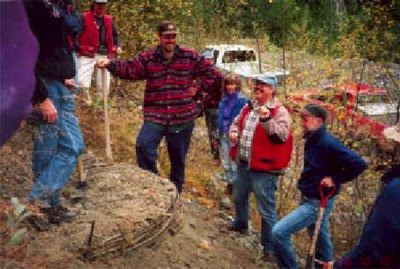 |
|

Project
Workforce and Supervision
Your project workforce and supervisor will make the difference between
a good and bad project, and you'll want to plan carefully.
Supervision
Your project supervisor may be a professional, or a project employee
with expertise or ready access to technical advice. In any case,
this person will need to be familiar with the ecological objectives
for your site so that changes can be made to the plans as issues
arise. Your supervisor should be comfortable with making on-the-spot
decisions: project planning can rarely foresee all the needs at
the site, and effective decision-making and delegation of responsibility
are essential (Ritchlin 2001). The supervisor will need to know
about obtained permits, and will be responsible for managing safety,
tools, materials and supplies. Your group may decide to hire an
outside specialist for this responsibility. You can get advice on
the appropriate specialist from your key
players, or from the BC
Chapter of the Society for Ecological Restoration.
Work
Force
Your project work force may be contractors, volunteers, staff, or
a combination of the three. Contractors can offer special skills
not otherwise available to your group - whether this is professional
advice and supervision, special tools, or skilled crews. In your
dealings with contractors you must be careful to explicitly define
the scope of work in a signed contract, including project milestones
or quality or quantity targets that will define payment. Don't pay
out the last of your contractor's invoices until the work is finished
and you are satisfied with the result. If your contract does not
contain a sufficient description of your expectations, you may have
to pay your contractor even if you are unhappy with the work - a
good reason to spend some time drafting a sound contract.

Dave Polster
Given training, volunteers can perform many
tasks with enthusiasm and commitment. Volunteers may become stewards
of your project and provide continuity for years to come.
Volunteers
are an important part of many projects. Besides offering their services
for free, they provide links to the community, and can be stewards
of your project in years to come. Your volunteers may be locals
with excellent knowledge of your site. You can also use volunteering
as a means to educate the public or school groups about the importance
of caring for the land (see 'Stakeholder
and Community Support'). When using volunteer labour you will
have to provide training, be clear about exactly what is expected,
and have good on-site supervision. Volunteer labour requires flexibility,
and the efforts of your volunteers need to be recognized, and celebrated.
Volunteers
and contractors have their limits, and you may prefer to assign
some staff members to carry out the work. Staff offer the advantages
of flexibility, accountability, and sometimes, long-term involvement.
However, permanent employees may be more expensive than contract
workers, and care needs to be taken that employees understand the
ecological objectives for the site. You must consider having Workers'
Compensation Board coverage in the event of on-the-job injuries.
|
Temporary
Staff, Payroll and Workers Compensation Board
|
|
Looking after temporary staff payrolls and
other employment expenses can be a major part of a restoration project.
It may sometimes be best to contract work out to reputable companies,
groups or individuals to avoid the administrative headaches of staffing
up. Using contractors also avoids the need to get and pay for Workers
Compensation Board coverage. You should ensure any contractors you
hire have a WCB insurance number, to avoid any liabilities to your
group.
|
|







